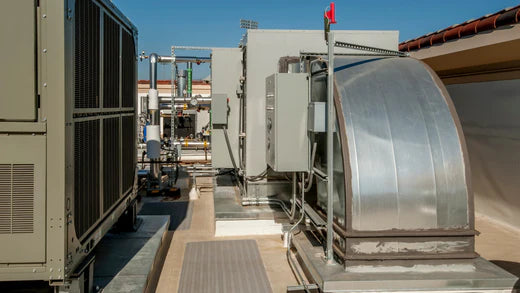
Smart Building Solutions: Revolutionizing Commercial HVAC Systems Market with IoT
Share

Introduction
In today’s fast-paced commercial real estate sector, businesses are placing an increased focus on efficiency, comfort, and sustainability. As part of this shift, the integration of cutting-edge technologies into building systems is becoming paramount, and leading the charge is the Internet of Things (IoT). Particularly within heating, ventilation, and air conditioning (HVAC) systems, IoT is transforming how buildings operate—enabling smarter, more sustainable, and more efficient environments.
For investors in the commercial real estate space, this is an exciting development. HVAC systems have long been the backbone of building operations, responsible for regulating temperature, air quality, and overall occupant comfort. However, traditional HVAC systems have operated in silos, struggling to adapt to the dynamic and changing conditions of modern buildings. Now, with IoT integration, HVAC systems can not only respond in real time but also anticipate needs and optimize performance like never before.
Real-Time Monitoring and Control: The Power of Data
One of the most significant advantages of IoT-enabled HVAC systems is their ability to leverage real-time data for enhanced monitoring and control. With the help of sensors, actuators, and cloud-based connectivity, IoT systems can continuously collect data on various environmental parameters such as temperature, humidity, air quality, and occupancy levels. This influx of real-time information gives building managers a comprehensive view of system performance and occupant comfort. The ability to make informed decisions and adjust settings on-the-fly drives operational efficiency, allowing buildings to optimize energy usage and reduce operational costs.
For investors, this means smarter, more effective buildings that deliver consistent returns. Real-time monitoring empowers managers to improve service levels, enhance energy efficiency, and reduce downtime—all leading to better financial outcomes for property owners and operators.
Predictive Maintenance: Stay Ahead of Potential Failures
IoT's predictive capabilities extend beyond real-time control to the crucial area of maintenance. Traditional HVAC systems often rely on reactive maintenance strategies, leading to costly repairs, unexpected downtime, and inefficient operation. With IoT-enabled HVAC systems, predictive maintenance can identify potential faults and anomalies in the system before they develop into significant problems.
By continuously analyzing data from sensors and equipment, IoT platforms can forecast when a component is likely to fail and recommend preventive actions. This not only saves money on repairs but also extends the lifespan of equipment, improves system reliability, and minimizes disruptions to the building's operations. For investors, this translates to reduced operational costs and a more predictable, sustainable bottom line.
Seamless Integration with Building Management Systems (BMS)
One of the standout features of IoT-enabled HVAC systems is their seamless integration with Building Management Systems (BMS). This integration is essential to unlocking the full potential of smart buildings. By centralizing control, the BMS allows for efficient data sharing across HVAC, lighting, security, and other building systems. As these systems communicate and work together, they optimize building-wide performance in real-time.
For building managers, this centralization leads to more coordinated and efficient operations. For investors, the increased automation and efficiency mean that properties can be operated at lower costs and with a greater level of precision, ensuring a superior experience for tenants and stakeholders alike.
Enhancing Occupant Comfort and Productivity
Ultimately, the goal of any smart building is to create a better environment for its occupants. IoT-enabled HVAC systems excel in this area by continuously adjusting to real-time conditions, ensuring that temperature, humidity, and air quality are always optimized for comfort. The result? Healthier and more comfortable indoor spaces, which directly contribute to enhanced productivity and tenant satisfaction.
In commercial real estate, tenant retention is a key concern. A building that offers consistently comfortable, healthy, and well-regulated indoor conditions not only improves occupant well-being but also ensures long-term occupancy and loyalty. For investors, this translates to reduced vacancy rates and a more attractive property in the competitive market.
Supporting Sustainable Building Practices
Sustainability is no longer a buzzword but a core value for businesses and building owners alike. The IoT integration in HVAC systems supports these sustainability goals by optimizing energy usage and reducing waste. IoT-enabled systems provide building managers with the tools they need to track energy consumption, identify inefficiencies, and implement energy-saving measures.
Additionally, IoT HVAC systems offer demand response capabilities, which allow buildings to adjust their energy consumption during peak demand periods. This not only contributes to grid stability but also reduces energy costs. In an age where sustainability is a key differentiator, these IoT-powered systems make it easier for buildings to meet regulatory standards, attract eco-conscious tenants, and reduce their environmental footprint.
Conclusion: A Future-Proof Investment Opportunity
The integration of IoT technology into commercial HVAC systems is a transformative force in the real estate market. By enabling real-time monitoring, predictive maintenance, seamless BMS integration, and enhanced occupant comfort, IoT solutions help buildings become more efficient, sustainable, and productive. For investors, this presents a compelling opportunity to capitalize on the growing demand for smart, connected infrastructure.
As the real estate industry continues to evolve, IoT-enabled HVAC systems offer a pathway to reduced operating costs, improved asset value, and long-term sustainability. For those looking to invest in the future of smart buildings, this technology represents a strategic and future-proof investment that will yield both operational and financial benefits.
In short, IoT is not just transforming HVAC systems; it is redefining what is possible in commercial real estate, driving a smarter, greener, and more profitable future.